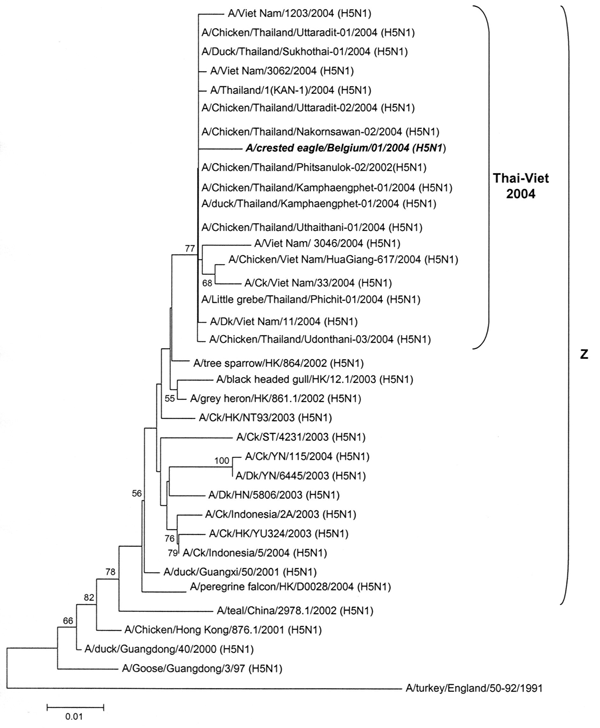Volume 11, Number 5—May 2005
Dispatch
Highly Pathogenic H5N1 Influenza Virus in Smuggled Thai Eagles, Belgium
Figure 2

Figure 2. . Neighbor-joining phylogenetic tree (rooted to A/turkey/England/50-92/1991) based on the alignment of a 654-bp fragment of the hemagglutinin gene of A/crested eagle/Belgium/2004 (bold italic), including the cleaving site. Bootstrap values >50 (1,000 replicates) are indicated near the branches. The Z cluster refers to Li et al. (10).
References
- Centers for Disease Control and Prevention. Cases of influenza A (H5N1)—Thailand, 2004. MMWR Morb Mortal Wkly Rep. 2004;53:100–3.PubMedGoogle Scholar
- Enserink M, Kaiser J. Avian flu finds new mammal hosts. Science. 2004;305:1385a. DOIPubMedGoogle Scholar
- Keawcharoen J, Oraveerakul K, Kuiken T, Fouchier R, Amonsin A, Payungporn S, Avian influenza H5N1 in tigers and leopards. Emerg Infect Dis. 2004;10:2189–91.PubMedGoogle Scholar
- Cyranoski D. Bird flu data languish in Chinese journals. Nature. 2004;430:955. DOIPubMedGoogle Scholar
- Suetens C, Snacken R, Hanquet G, Brochier B, Thomas I, Yane F, Eagles testing positive for H5N1 imported illegally into Europe from Thailand. Eurosurveillance, 2004;8(44). Available from http://www.eurosurveillance.org/ew/2004/041028.asp
- Lee M-S, Chang P-C, Shien J-H, Cheng M-C, Shieh HK. Identification and subtyping of avian influenza viruses by reverse transcription-PCR. J Virol Methods. 2001;97:13–22. DOIPubMedGoogle Scholar
- Stockton J, Ellis JS, Saville M, Clewley JP, Zambon MC. Multiplex PCR for typing and subtyping influenza and respiratory syncytial viruses. J Clin Microbiol. 1998;36:2990–5.PubMedGoogle Scholar
- Yuen KY, Chan PK, Peiris M, Tsang DN, Que TL, Shortridge KF, Clinical features and rapid viral diagnosis of human disease associated with avian influenza A H5N1 virus. Lancet. 1998;351:467–71. DOIPubMedGoogle Scholar
- Hulse DJ, Webster RG, Russell RJ, Perez DR. Molecular determinants within the surface proteins involved in the pathogenicity of H5N1 influenza viruses in chickens. J Virol. 2004;78:9954–64. DOIPubMedGoogle Scholar
- Li KS, Guan Y, Wang J, Smith GJ, Xu KM, Duan L, Genesis of a highly pathogenic and potentially pandemic H5N1 influenza virus in eastern Asia. Nature. 2004;430:209–13. DOIPubMedGoogle Scholar
- Horimoto T, Kawaoka Y. Biologic effects of introducing additional basic amino acid residues into the hemagglutinin cleavage site of a virulent avian influenza virus. Virus Res. 1997;50:35–40. DOIPubMedGoogle Scholar
- del Hoyo J, Elliott A, Sargatal J. Handbook of the birds of the world. Vol.2. New World vultures to guineafowl. Barcelona: Lynx Edicions; 1994.
- Lee CW, Suarez DL. Application of real-time RT-PCR for the quantitation and competitive replication study of H5 and H7 subtype avian influenza virus. J Virol Methods. 2004;119:151–8. DOIPubMedGoogle Scholar
- Manvell RJ, McKinney P, Wernery U, Frost K. Isolation of a highly pathogenic influenza A virus of subtype H7N3 from a peregrine falcon (Falco peregrinus). Avian Pathol. 2000;29:635–7. DOIPubMedGoogle Scholar
- Magnino S, Fabbi M, Moreno A, Layazza A, Ghelfi E, Avian influenza virus (H7 serotype) in a Saker Falcon in Italy. Vet Rec. 2000;146:740.PubMedGoogle Scholar
Page created: April 24, 2012
Page updated: April 24, 2012
Page reviewed: April 24, 2012
The conclusions, findings, and opinions expressed by authors contributing to this journal do not necessarily reflect the official position of the U.S. Department of Health and Human Services, the Public Health Service, the Centers for Disease Control and Prevention, or the authors' affiliated institutions. Use of trade names is for identification only and does not imply endorsement by any of the groups named above.